2017 Audi Q7: First Drive
Audi’s three-row SUV gets a new look, more space and a major upgrade in technology.

What it is: 2017 Audi Q7, seven-passenger luxury SUV
Price Range: Starts at $54,800
Competitors: Mercedes-Benz GLS, BMW X5. Cadillac Escalade, Land Rover LR4
Alternatives: Toyota Highlander, Chevrolet Tahoe, Mazda CX-9
Pros: Impressive standard safety features, more interior space and a stellar virtual cockpit.
Cons: No true third-row seat unless you have kids that are rather small or adults that enjoy being uncomfortable.
Would I Buy It With My Own Money: While it might not be my first choice in the world of seven-passenger SUVs, the solid tech and great space in the Audi Q7 makes it a strong option.
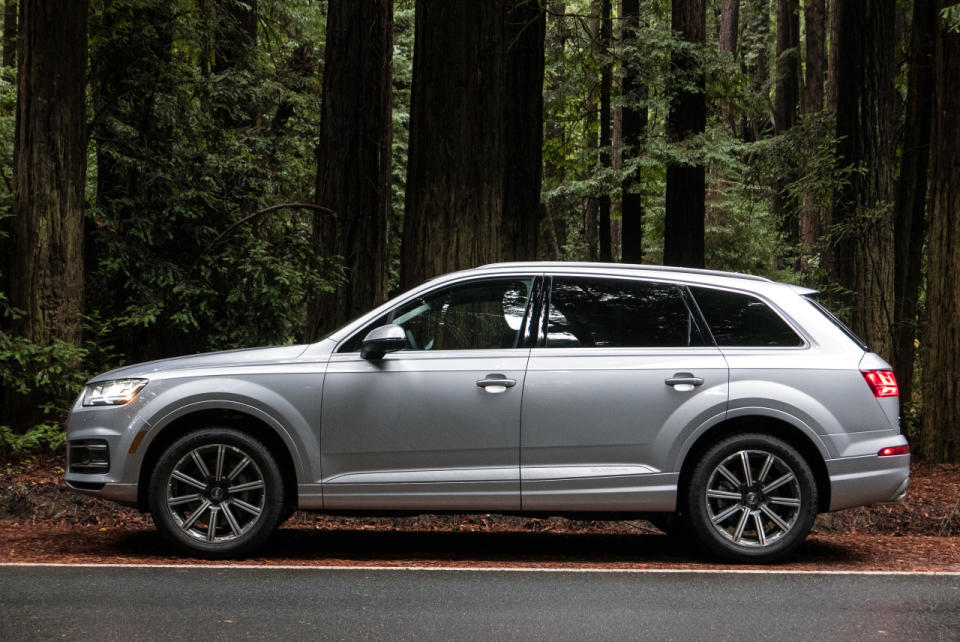
Outside its pure sports cars, Audi isn’t known for excitement. Most of the sedans are a bit boring; good looking, beautifully made cars quietly carrying passengers to and from their destinations with nary a notice being taken. The SUVs share the same genetics, and feedback about the previous generation flagship SUV, the Audi Q7, was no exception. It got accolades for being elegant albeit, perhaps, too elegant.
The new 2017 Audi Q7 however, has hunkered down, lightened up, and added more space and more technology making it a much more appealing. While we drove the European version of the car in the Swiss Alps back in May, the latest version to hit U.S shores still impresses, making it a solid choice in the seven-passenger arena.
First, Audi took the upright, angular, three-dimensional grille that it’s been using on its cars (like the A4 and the TT) and passed it onto the flagship SUV. Sharp double shoulder lines give the body a substantial and angular presence that the previous generation didn’t have.
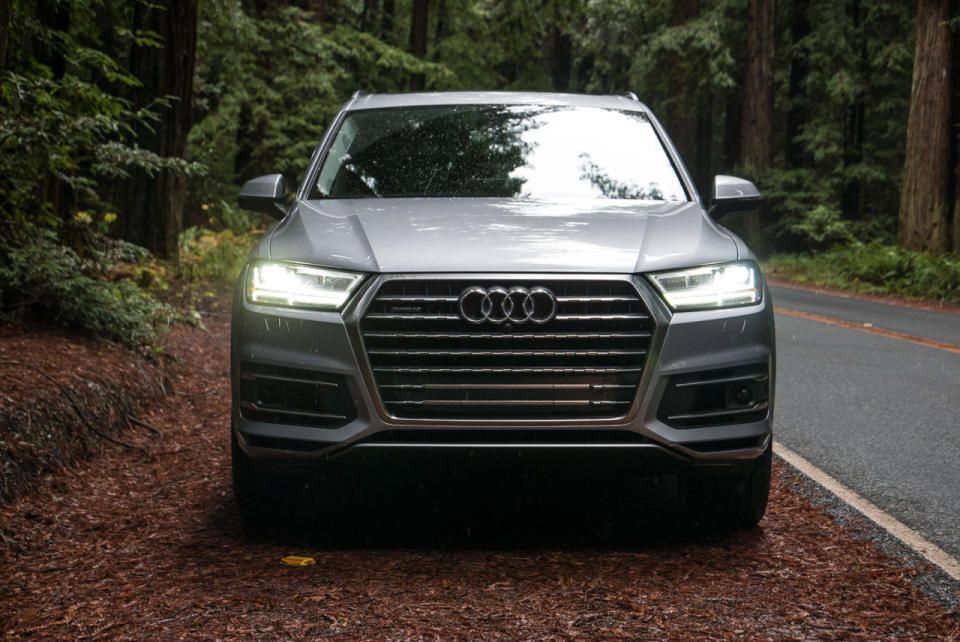
While being essentially the same dimensions on the outside, the new Audi Q7 gets more interior space than the previous generation. Designers achieved this by giving door panels and the backs of the seats cut-outs for shoulders and knees. They have also added a fixed, staged infotainment screen in the center of the dash and a small line of LED lights that sweep the entire interior dash front and act as both illumination when you enter and exit the car, but also as warning lights when you go to open the door in to oncoming traffic. The interior of the cabin feels spacious and ample enough to comfortably seat at least five adults. While the third row has gained a bit of space thanks to a more compact rear suspension and lower floor, and it does allow for an additional two passengers, those folks had better not be large—or you had better not take them far. It’s not a spot for full-size adults no matter how often they practice yoga.
The 2017 Audi Q7 has dropped nearly 500 lbs. compared to its predecessor. Of that, 253 lbs. came from the new suspension and body composition. Aluminum body panels and an all-new chassis help give the Q7 more interior space. The new design and smaller center differential means that the floor inside the Q7 is lower than it was in its predecessor, making more room for luggage and passengers.
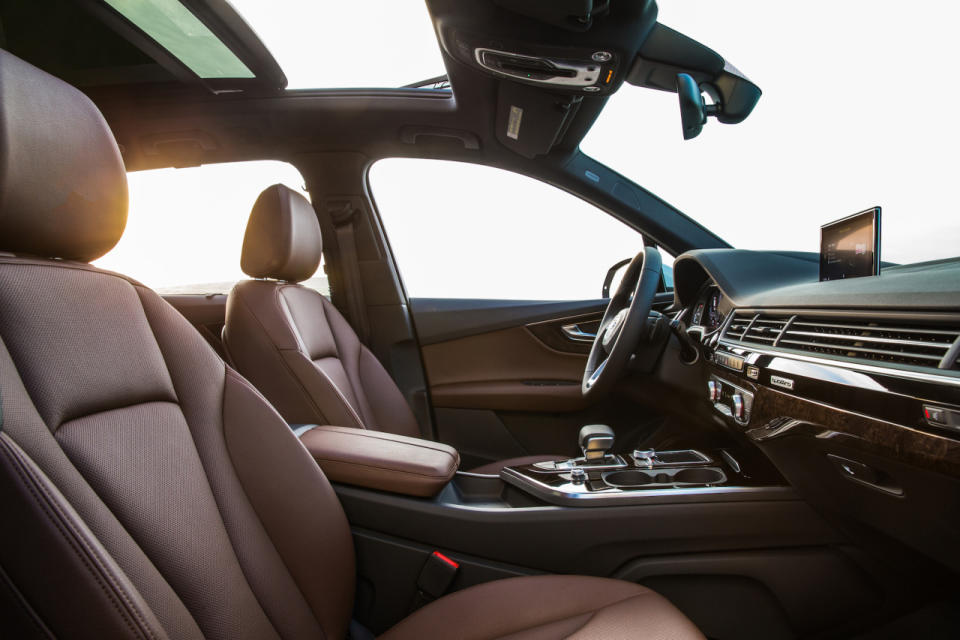
Audi has outfitted the new Q7 with more than 31 driver assistance packages. While we did have a real-world experience with Audi’s pedestrian avoidance system in Austria, we had a chance to test out some of the other new systems on a test course in a parking lot.
First we tried out the rear cross-traffic alert system. The system uses two radar sensors embedded in the bumper of the Q7 that scan crossing traffic while backing out. If you aren’t paying attention, the system alerts you with visual cues, and then strongly applies the brakes if you continue to back into traffic. We experienced both as the engineer who was demonstrating the system explained how it worked. A driver in another car came rapidly up from the driver’s side and the engineer continued to back up. When the car sensed that there might be a collision, it first sent out an audible chime and then stiffly applied the brakes, preventing a collision.
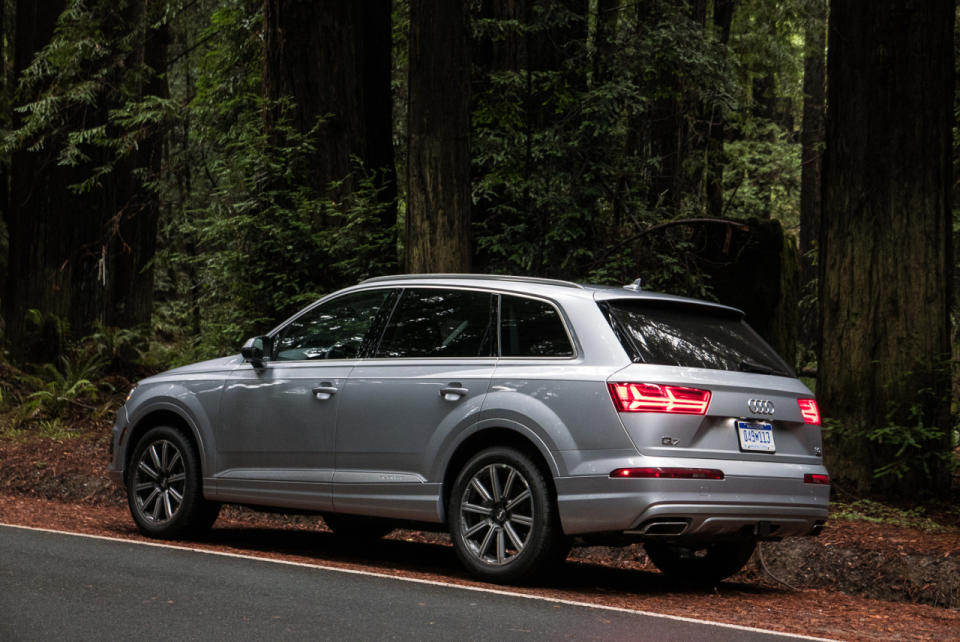
The next system we tested was the collision avoidance system. The idea behind the system is to hold you in your lane to help prevent frontal collisions. Using the forward-looking camera mounted behind the rear view mirror in the windshield, the Q7 can detect when you are about to turn into oncoming traffic. To demonstrate the system an engineer initiated a turn into an oncoming vehicle. The first time we tried it, the engineer had to apply the brakes himself, as the system didn’t initiate correctly. According to the driver the system didn’t work because we were not driving on a mapped and painted road and the system didn’t recognize it. Fair warning—that means it likely wont work if you accidentally turn into an oncoming car in a parking lot. The next time, the system did work, and the Q7 again sent out an audible alert and then applied the brakes, holding the car in the lane until the oncoming car passed.
Finally we got a chance to try out Audi’s Presense Plus—a system that not only senses and warns about collision, but also can stop the car at up to 137 miles per hour. In this test the engineer drove up to about 20 mph at a fake car. When we approached, warning lights on the dash lit up; since the driver did not apply the brakes, the car automatically did, stopping us just short of the false car. We tried the same process with both child and adult mannequins (this system only works up to 52 mph) and as we noted during the drive in May, the system worked the way it should.
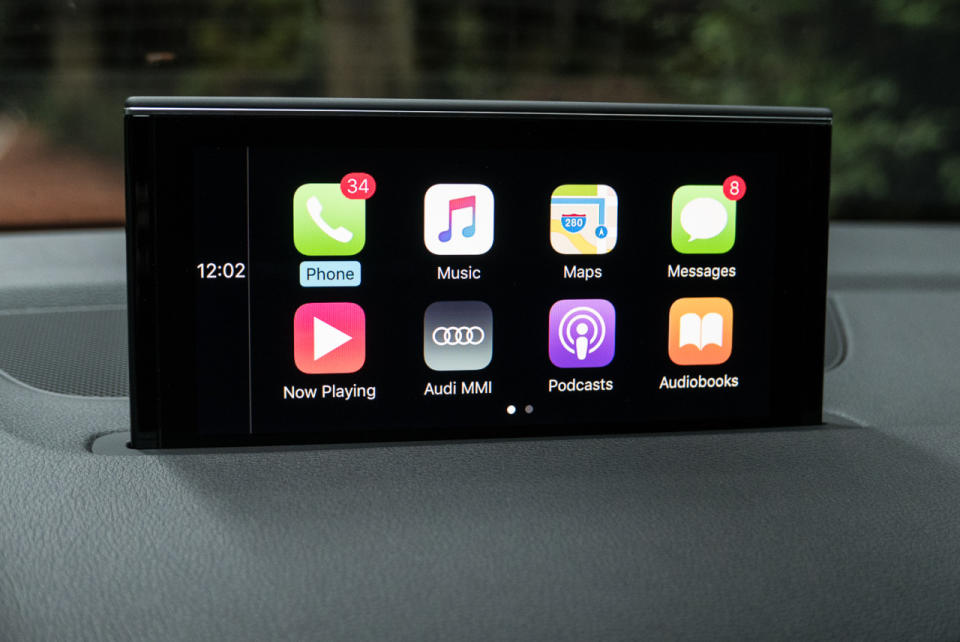
In addition to these active safety features, Audi offers a suite of available technology that includes everything from Apple Car Play and Android Auto to the ability to open your Q7 using your phone. Through their proprietary system called Audi Connect you can set various tracking situations for your Q7. These include a “curfew,” a system that can alert you when the Q7 has been started or stopped between certain hours; speed and valet alerts, a system that alerts you when the car is out of your possession (like with teenagers or valets); and geo-fencing, alerting the main owner when someone has entered or exited a specified, geo-located area. You can also remote lock and unlock your Q7 using Audi Connect.
An additional feature that Audi has built into the ESC system is the ability to detect whether or not there is a load on the roof. A proprietary rack attaches to rails on the Q7’s roof, and when a load is detected the damper settings are automatically adjusted to keep the Q7 planted. We didn’t get a chance to try out the system, but it definitely sounds like a welcome addition when carrying a bunch of people and a roof load of skis, bikes, or luggage.
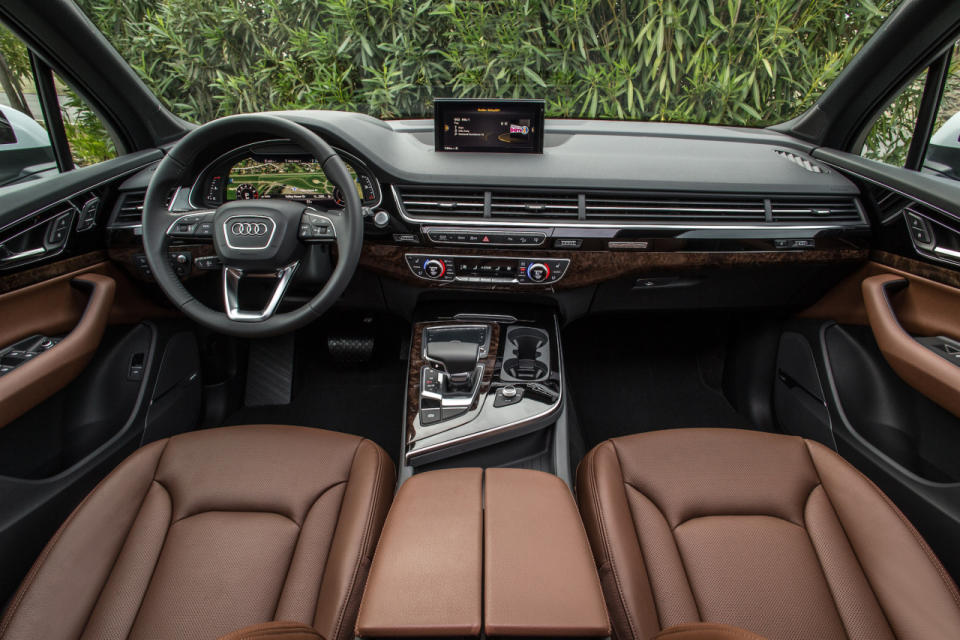
With an electronically limited top speed of 130 mph, the Audi Q7 is powered by a 3-liter, V-6 with 333 hp and 325 lb-ft of torque, mated to an eight-speed automatic and Audi’s Quattro all-wheel-drive—all good for a run from zero to 60 mph in 5.7 seconds. In the base version you get a five-link steel spring front and rear independent suspension. An optional upgrade will get you the air suspension that can be adjusted based on your driving style using Audi’s MMI system or by using hard keys on the dash.
The steel suspension is a good choice if you want to save some money but the air suspension is where I would put my money. We did however find that the Q7’s body motion when equipped with the air suspension tended to make our front seat passenger a bit nauseous on some seriously curvy roads (in some extremely heavy fog) along the coast of Northern California. The Q7 shares a platform with the other luxury SUV in the VW Group catalog, the Bentley Bentayga that we drove in Spain, and it gave our front-seat passengers the same experience.
Along with the Bentayga, the Q7 also shares the same platform as the Audi A4 and A8. That makes it handle relatively well, but, despite Audi’s insistence, it’s still not as nimble as a sedan. On the roads around Napa Valley it felt planted and stable in corners, and certainly didn’t feel nearly as large as other seven-passenger SUVs we’ve driven.
On the road, the driver assistance systems are good, but not nearly as strong as some others we’ve experienced. The lane-keeping system has a tendency to make both driver and passenger nervous as it likes to get awfully close to both lines before deciding to guide the car back towards the middle of the lane. The system also does have the tendency (like most) to bounce the car from one side of a wide lane to another. Beware: it also cuts on and off randomly. Green lines in the heads-up display and on the virtual dashboard show you when the system has detected road guide lines that allow the system to work—and sometimes those lines turn grey, meaning that the system doesn’t have any guidance at all. The system isn’t intended to be completely autonomous, but it does require more driver input than others out there.
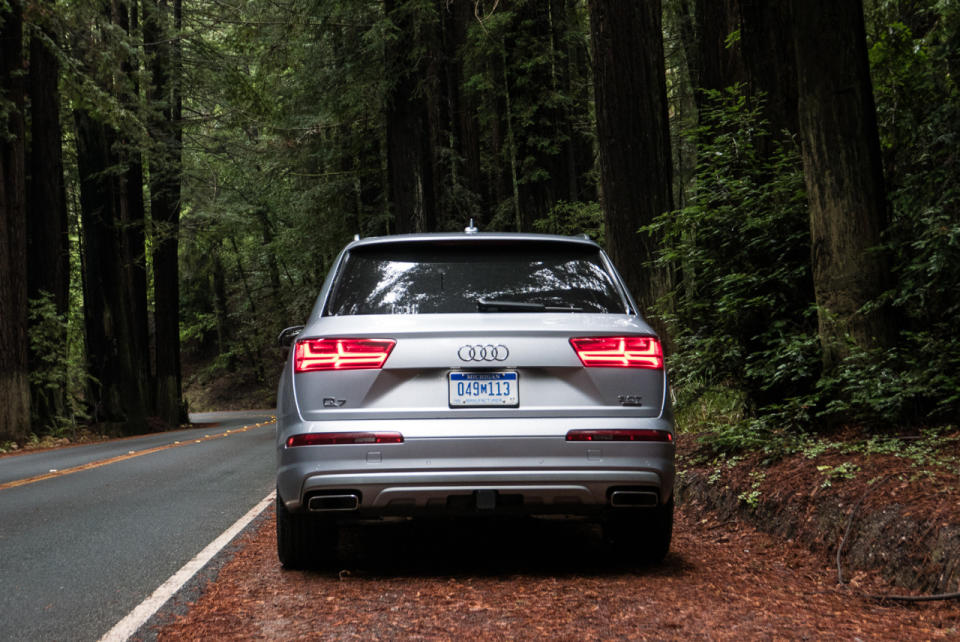
EPA estimates are still forthcoming, but Audi says you can expect the new Q7 to get similar gas mileage to the current one. While the 2017 Audi Q7 is still elegant, it has beefed up its offerings with a suite of new technology and more space inside a good-looking package—and that will be a suitable alternative to excitement for many.

 Yahoo Autos
Yahoo Autos 